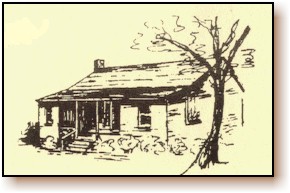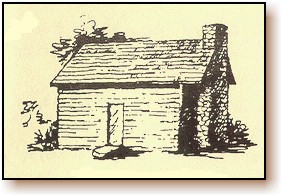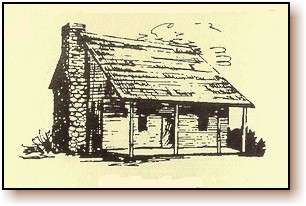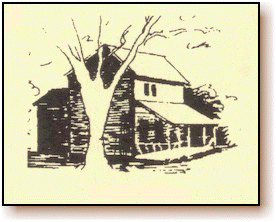

Moore County, North Carolina has many historical homes. Some preserved
and open to the public. Others not so well known. More will be added
as we get out and locate them. Please enjoy this view to the past,
and come back often to see what's been added.
![]() Shaw
House
Shaw
House ![]() Britt Sanders Cabin
Britt Sanders Cabin ![]() Garner
House
Garner
House
![]() Bryant
House
Bryant
House ![]() Joel
McLendon Cabin
Joel
McLendon Cabin

 |
The Historic Shaw House is located on its original foundation at the crossroads of the famed Revolutionary Pee Dee and Morganton Roads at the southern entrance to Southern Pines. The Pee Dee was an ancient Indian Trial and ran between Cheraw and its northeastern settlements, while the Morganton ran from the market town of Fayetteville on the Cape Fear River. |
| The Shaw House is typical of the antebellum homes which
followed the cabins of the early Sandhills settlers. It is less elaborate
than the seacoast plantations and has the charm of sturdy simplicity which
was characteristic of the Scottish families who settled in this region.
The interior is highlighted by fine detail on two hand-carved fireplace
mantles of unusual beauty, and by many outstanding examples of Moore County
pottery and "plain-style" pine furniture. A wing was added to the house
in the mid-1800's and a kitchen was added sometime in the 1920's.
Charles C.Shaw, a first generation Scottish settler, acquired 2500 acres and built the house around 1820. The date of 1842 on the chimney is thought to have been the year that the front porch and the two additional "travelers' rooms" were added. One of his twelve children, Charles Washington Shaw, inherited the property and lived in the house, becoming the first mayor of Southern Pines in 1887. The house remained in the Shaw Family until it was acquired in 1948 by the newly formed Moore County Historical Association in a grassroots effort to ensure its preservation. The Shaw House Properties are open for tours and visitors on a regular schedule and at other times by appointment. Private luncheons for groups of 10 to 25 are also available. Please call the Shaw House at 910/692-2051 for hours of operation, to schedule luncheons, and other information. |
The Britt Sanders Cabin was moved to its present location, on the Shaw House Properties, from rural northern Moore County in 1952. It was in a state of advanced deterioration with damaged logs, crumbled roof and a fallen chimney. It took love and determination to raise the money to move and restore it. |
 |
| Built in the late 1700's by Britt Sanders whose family
consisted of a wife and ten children, it is a fine example of the early
Sandhills settlers one-room cabins. It is of typical of Scot-German construction
with hewn logs and half dove-tailed notches producing a solid and durable
dwelling. There were no windows in the original cabin and the floor was
of red clay. The sleeping loft upstairs is typical; the main floor provided
space for living, sleeping, cooking, washing and weaving.
Notable are the sand hearth for cooking, the cruse lamp hanging by the fireplace and the antique candle molds. The old trammel by the fireplace is designed to hang inside the chimney on a an iron pole which was inserted during construction. The loom was necessary for a family, as everything must be made, and cloth was a precious commodity. The beautiful chimney of native river rock is protected from the elements by a wide overhang. Chinking originally was a mixture of mud, clay and hair and had to be replaced yearly. Yards in the early Sandhills were swept clean as a daily chore, both to keep down the danger of fires and as matter of neatness. The entire family worked together, and "recreational" activities for the children largely consisted of learning skills. It was a hard existence by our standards, but it was by no means a drab one. The family provided stability and was a cohesive factor in the life of the early settlers. |
 |
The Garner House, now on the Shaw House grounds, was originally located on the property of Mrs. Melvin Garner, off State Road 1456 north of Robbins. John Garner bought the land in 1764, and his son Lewis was born on the property in 1793. It was purchased by the Association in 1986. Family members believe that Lewis built the house early in the 19th century, but it possible that John may have built it in the 1700's. |
| The house is unaltered and intact, and is one of the finest
examples of the typical rural homes of early Moore County that remains
today. It is distinguished by wide hart-pine paneling with fine quality
moldings at the windows and doors. The original hand-forged hinges and
posts are intact on the doors which are also original to the house.
The walls of the three rooms on the ground floor are of unpainted, hand-planed pine boards which glow with the original patina. The interior doors have early cast hinges in contrast to the forged hardware on the exterior doors. A corner stairway with winders leads to the second floor which features exposed log construction and a fireplace with hand-made brick. The large pine logs forming the structure are 13 to 16 inches wide and are hewn 7 to 8 inches thick. The house measures a 20 by 24 feet and has an attached 8 by 24 foot porch. The stone and brick chimney opens to a fireplace on each floor. The first floor features the original pegged mantles with early blue paint. Much of the furniture is original to the house, including the two painted cupboards and the scrubtop table. The painted sash is also original, and some of the original glass remains intact on the front of the building. The house had a separate kitchen which was too deteriorated to move. |
James Bryant acquired the McLendon Place from his father Michael early in the nineteenth century with the McLendon Cabin already in place. Bryant later built the manor house there about 1820. James Bryant's great-granddaughter, Flossie Bryant Davis and her children gave the houses with 3.4 acres to the Moore County Historical Association in 1969. |
 |
| Restoration of the structure in the early 1970s included
straightening the chimneys and replacement of the shake roof. Special features
include two fine mantels, handmade doors and window sash, hand-hewn heart-pine
girders and sills. Neither dwelling had been altered prior to restoration
and both had been continuously occupied until the 1940s.
Furnishings for the house were acquired for the Association by Mrs. Ernest Ives, Mrs. John Labouisse and the Davis family. Both the Bryant Manor House and the McLendon Cabin were opened to the public in May 1976. Mrs. Davis, then 91 years old, attended the opening with several of her children, grandchildren and great-grandchildren. Mrs. Davis was born and grew up in the house and raised her own family of six boys and seven girls there. |
 |
When Joel McLendon came to Moore County in 1758 to claim his grant of 200 acres, he selected a slope overlooking Buck Creek as the perfect site for his home. Although a simple one-room log structure, it was built with the typical integrity of the early settlers that has preserved it for over 200 years. |
| A little farther downstream he built and operated a grist
mill and Buck Creek soon became known as McLendon's Creek, just as the
road below his cabin came to be called Joel's Road. In 1787 McLendon sold
his property to Robert Graham, whose daughter married Michael Bryant, and
their son James succeeded to the land. When James Bryant constructed his
larger house he built it adjoining the McLendon Cabin, where the two houses
sit to this day.
The McLendon Cabin is the oldest house in Moore County on its original location. The circa 1760 structure is typical of the log dwellings built by the early settlers of the region. The house was restored in 1970 by the Moore County Historical Association under the leadership of Mrs. Ernest Ives. The Bryant House and the McLendon Cabin are located at Harris Crossroads in upper Moore County. From the traffic circle at Pinehurst, take 15-501 towards Carthage, turn west on NC 73, go to the intersection of Beulah Hill Church Road and take a right. Go straight through two crossroads, the second being Harris Crossroads. The house are located down a hill on your right at a state highway marker. The houses are open Sundays from 2-5 and by appointment. Call site manager Max Richardson at 947-3995 for information or to schedule a tour. |
![]()